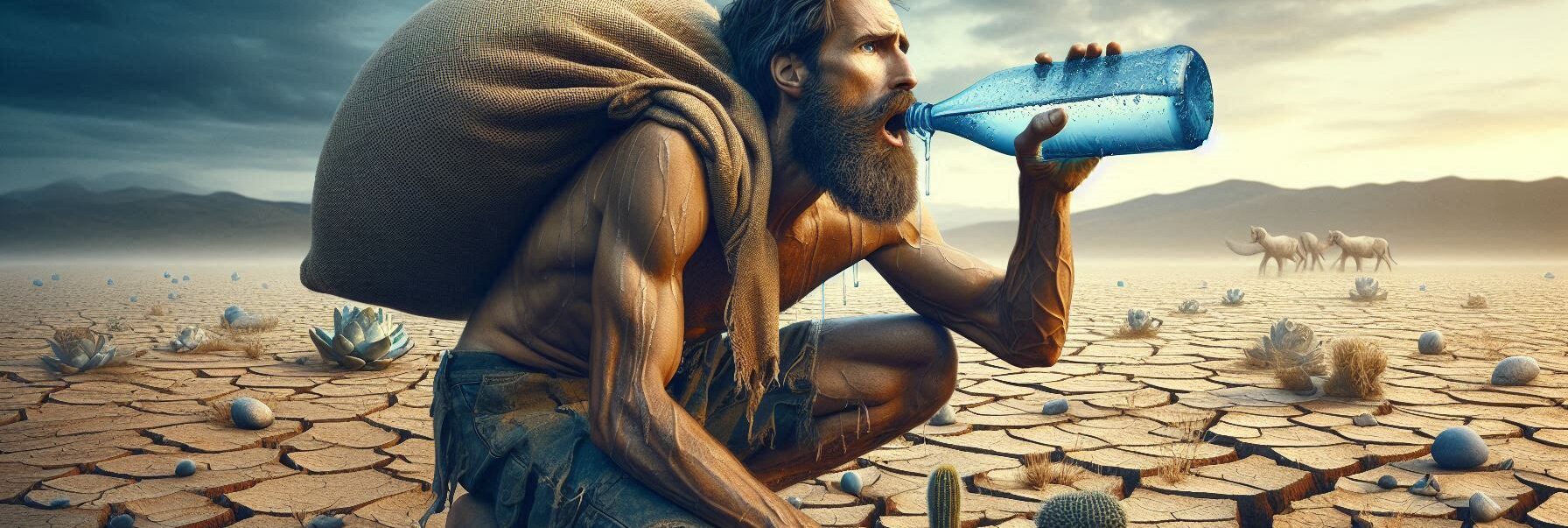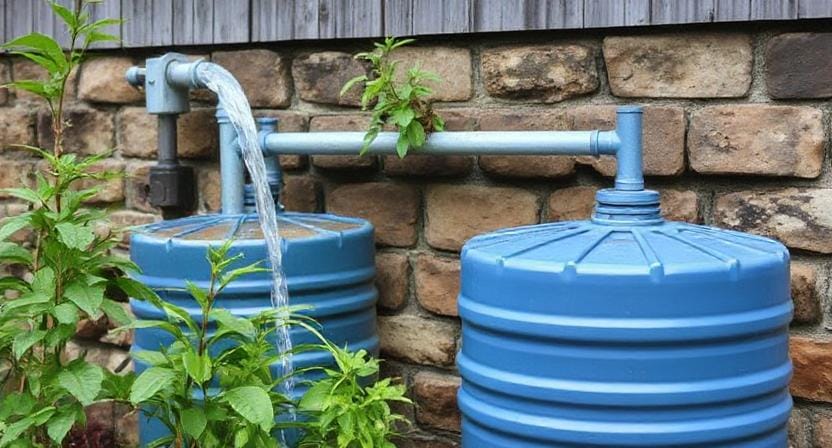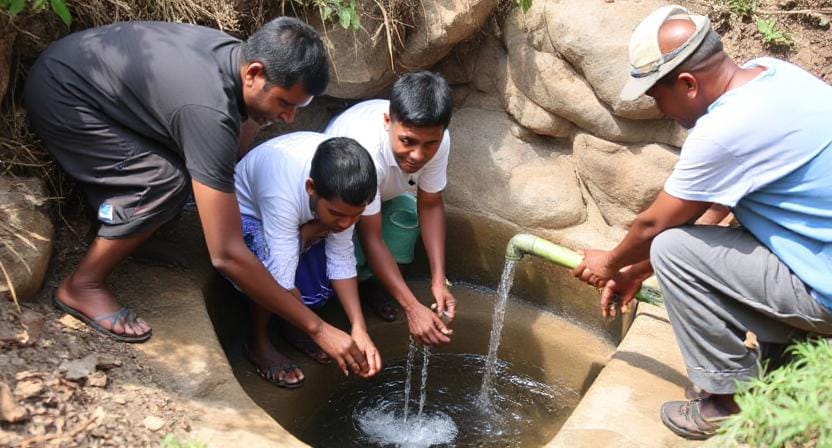Top Takeaways and Key Concepts
- Calculate personal water needs and plan daily usage to avoid shortages during emergencies.
- Store at least one gallon of water per person per day for preparedness.
- Harvest rainwater safely using covered barrels and basic filtration systems.
- Conserve water at home by fixing leaks and installing low-flow devices.
- Build a water emergency kit with purification tools and backup containers.
Summary of This Article
This article explains why water preparedness is essential and how anyone can take simple steps to secure a safe water supply. It highlights water scarcity as a growing global issue and encourages practical solutions like storing water, harvesting rainwater, fixing household leaks, and conserving resources daily. It also recommends building emergency water kits and working together as a community to promote sustainability. With planning and action, staying hydrated and ready for unexpected challenges becomes easy and achievable.
Short Video Version of this Article
Isn’t life a crazy ride? Lack of water isn’t simply a problem for lizards that live in the desert or that friend who constantly forgets to pay their water bill. Nope! It’s a significant deal for all of us. It might make us feel thirsty, like really dry.
Please Note: This post may contain affiliate links. If you click one of them, we may receive a commission at no extra cost to you. As an Amazon Associate, I earn from qualifying purchases.
Think about this. It’s really hot outside and you’re on a trek. You try to get your water bottle, but it’s empty. Oh no. Not fun, is it? We have to plan for the future.

Let’s talk about this in a way that shows how serious it is, like if a cat suddenly found itself in a bathtub. It’s also a good idea to have some fun while we’re doing it. We can learn how to save water and do so in a wise way. We may take brief showers or turn off the water while we brush our teeth.
Every little bit counts.
We can also get ready for what’s coming. It’s a good idea to have additional water bottles on hand. It can also help a lot to find cool gadgets that save water. And talking about this with pals could help you come up with some fantastic ideas.
Let’s keep ahead of the curve. We can do this because water is valuable. Friends, drink plenty and remain hydrated!
Understanding Water Scarcity

What exactly is water scarcity? It’s not just when your teenager takes an hour-long shower while you’re trying to wash your hands.
Water scarcity occurs when demand outstrips supply or when access to safe drinking water is limited. And folks, it’s happening all over the world! From California’s droughts to Cape Town’s infamous “Day Zero,” where taps ran dry faster than you can say “sippy cup,” it’s becoming a real issue.
Did you know about 2 billion people live in places where water is really hard to find? That’s a lot! They might end up sipping on bottled air if we don’t act fast. Crazy, right?
So, how do we get ready for this challenge? No need to go into panic mode—no one wants to clear out the grocery store like it’s a giant game of musical chairs.
Let’s try some smart ideas instead. Think about ways to save water at home. Maybe grab a cool water bottle that you can refill. Staying hydrated while being eco-friendly is a win-win!
You can also help out by sharing. If you know someone needs help with their water situation, be there for them. Maybe start a neighborhood garden, where everyone can pitch in. Growing your own veggies uses less water and it’s so much fun!
When you’re out and about, bring along a reusable bottle. Fill it up wherever you go. Stay away from the impulse of buying bottled water. It feels good to help the planet, too!
Keep talking about water with your friends and family. Sharing ideas can make a difference. Let’s turn this challenge into a chance to be smarter with our water use!
Rainwater Harvesting: Your Personal Reservoir

Have you ever thought about gathering rainwater? That sounds like something only serious survivalists would do, right? But listen to me!
Setting up barrels beneath your gutters to catch the rain is all it takes to collect rainwater. Like a surprise present from Mother Nature, you wouldn’t believe how much free water can descend from above!
Do you know what’s very cool? Collecting rainwater! It’s like being a superhero for water. You can use it in your home or store some for the garden. It’s safe as long as you use the correct filters! While your pals are hurrying to get their last bottle of sparkling water, you may say, “Hey, I’m saving rainwater!” You can brag all you want!
Take a moment to think about it. You can catch all that free water when it rains. You can fill up buckets or barrels. Just don’t forget to cover them. You don’t want mosquitoes to have a good time in there. Oh no! No one likes those annoying pests.
Also, using rainwater is good for the planet. Every little bit helps, right? The rainfall will be great for your plants too. They’ll be happy and healthy, and you’ll feel good about helping them.
It’s interesting how something so simple can have such a large effect. You can become a water-saving champion in just a few steps. And who knows? While your pals are out looking for water, they might ask you for advice. Let’s start saving that rain!🌧️
Efficient Water Use at Home

Now let’s see how we can conserve the precious H2O right within our homes. Simple changes can make a big difference—think low-flow showerheads and faucet aerators that reduce flow without sacrificing pressure. Honestly, who doesn’t love feeling like they’re standing under Niagara Falls during their morning routine?
And speaking of showers, have you heard of the “navy shower”? This technique involves turning off the tap while lathering up and then turning it back on briefly for rinsing.
You know, it kinda feels like sailors came up with this water-saving idea after realizing they were wasting water faster than they could fill their cups. But hey, it totally works!
And let’s talk about leaks. Ugh, those sneaky little things. They’re like a money thief right in your home. Imagine that drip-drip-drip sound. It’s like a sad little drummer just hanging out. No audience, just wasting water and your hard-earned cash.
Checking for leaks is easy. Look under the sink, check the toilet, even see if your faucets are acting all funny. A tiny drip might seem harmless, but over time, it adds up. You could be saving gallons of water. That’s pretty amazing, right?
Fixing those leaks isn’t just smart; it’s like giving your home a little tune-up. You’ll feel good knowing you’re not just wasting water. Plus, you might even notice your water bill getting smaller. Who doesn’t love that?
So, grab a cup of coffee, take a little walk around your house, and see what you can fix. It’s simple, it’s rewarding, and it’s a great step toward being a water-saving hero!
Community Efforts: Working Together

It’s fantastic to do things on your own, but communal projects are where the true magic happens! You may work with your neighbors to promote conservation techniques or even launch local initiatives to cut down on overall usage.
How much fun would it be to gather everyone together to trade recipes? Picture everyone bringing their favorite foods that don’t need a lot of water. You can make these great salads using a lot of lettuce. Did you know that lettuce doesn’t need as much water as other vegetables? That is so cool! Everyone could leave with some great new ideas.
And you might want to plan some bigger community projects as well. Have you heard of permeable pavement, for example? It seems like magic! It enables rainwater soak into the ground instead of just running off. It also makes neighborhoods appear incredibly lovely. Also, rain gardens are great. They capture all the rainwater and make it into a nice garden. You’re making your street look nice and helping the environment at the same time. Two wins!
Imagine people talking while they plant flowers and grass and eat fresh salads. You feel good inside since you’re helping your neighborhood. Everyone would be very proud.
It’s important to work together and have fun while saving water. Who would have thought that solving water problems could be so much fun? One salad and one garden at a time, let’s make our town a better place!
Emergency Preparedness Kits

You know how life can throw surprises at us? Sometimes, we really need backup plans. Water shortages? Yeah, that’s a biggie. Making an emergency preparedness kit is a smart idea, trust me.
Imagine filling it with the essentials. Bottled water, of course. I know, I know—it feels so cliché. But hey, it works! Throw in some purification tablets, filters, and those lightweight containers for extra water. Just think about having clean drinking options right when you need them.
Stashing supplies in different spots is pretty clever, too. Who wouldn’t want to find some extra goodies hidden behind those dusty old board games? Picture this: years later, you’re digging through your closet and—bam! There’s your stash of emergency supplies. You’ll feel like a treasure hunter!
It’s almost like a little gift to your future self. No one wants to scramble around looking for help when it’s too late. With just a little planning, you can be ready for anything.
So go on, gather those supplies! Make it a fun little project. You and your friends can even make it a game—see who can come up with the best stuff to add to the kit. You’ll feel so smart and prepared. Seriously, one day you’ll thank yourself for thinking ahead.
Conclusion: Staying Hydrated & Hopeful
It can be scary to get through these tough times when there isn’t enough water, right? But really, it doesn’t have to seem like a huge burden. We can make a tremendous difference by taking little measures.
Give it some thought. It doesn’t have to be all serious to save water. It can be a lot of fun! Get together with your neighbors for some fun community events, like a rain barrel party. Everyone brings their barrels, and you all study at the same time. And think of all the fun you’ll have!
You become a part of something bigger before you know it. It’s important to be proactive. Every little bit helps. And don’t forget to be ready for yourself! It’s quite sensible to have your own water supply.
Get that rain barrel and start today. Putting even a little work today can make a big difference later. When will Mother Nature surprise us? That’s really wonderful that you’ll be ready. Let’s do this as a group. It feels nice to lend a hand, doesn’t it? You can do this!
Water preparedness is essential for survival and daily comfort, especially during droughts or emergencies. By storing clean water, conserving daily use, harvesting rainwater, and creating a water emergency kit, anyone can build a reliable personal water plan. Small steps taken today can prevent serious water shortages tomorrow.
Frequently Asked Questions
How much water should I store for emergencies?
You should store at least one gallon of water per person per day, covering both drinking and basic hygiene needs. For long-term emergencies, increasing this amount is even better.
What is the best way to harvest rainwater safely?
Use a covered rain barrel connected to your gutter system and add a basic filter or screen to remove debris. Always keep containers sealed to prevent mosquitoes.
How can I conserve water at home every day?
Simple habits like fixing leaks, using low-flow showerheads, turning off the tap while brushing teeth, and taking shorter showers can save significant amounts of water.
What should I include in a water emergency kit?
A water emergency kit should include bottled water, purification tablets, portable filters, water storage bags, and collapsible containers for backup use.
Is harvested rainwater safe to drink?
Rainwater can be used for plants and cleaning right away, but it must be properly filtered and disinfected before it is safe to drink.
How do I calculate my household’s water needs?
Start by multiplying one gallon per person per day, then add extra for cooking, pets, cleaning, and special health needs to get a realistic total.
What are signs my community may face water scarcity?
Warning signs include falling reservoir levels, frequent droughts, water restrictions, and rising water prices. Preparing early can prevent shortages.
Suggested Resources:
Rainwater Harvesting Basics
https://www.epa.gov/rainharvesting
Water Conservation Tips
https://www.wateruseitwisely.com/
Preparing Your Family for Emergencies
https://www.ready.gov/family-preparedness

Kevin Collier is a seasoned outdoor enthusiast and writer for Trekbug.com, specializing in outdoor adventures, survival strategies, and prepping insights. With a deep love for nature and a commitment to self-sufficiency, Kevin empowers readers to embrace the wilderness confidently. He shares valuable tips, practical techniques, and inspiring stories, helping both novice and experienced adventurers develop essential skills for surviving and thriving in the great outdoors.





